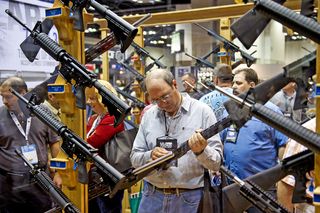Why Do Firearm Injuries Drop During NRA Conventions?

People are injured by firearms every day, but fewer gun-related injuries per capita happen during a certain yearly event: the National Rifle Association (NRA) Annual Meetings and Exhibits, according to a new study that looked at eight years' worth of data.
A team of scientists spearheaded the research, published today (Feb. 28) in The New England Journal of Medicine, after wondering whether the attendance of more than 80,000 people at the conference every year led to a drop in firearm injuries during convention days. They investigated the idea by comparing hospital records for firearm injuries during convention days to the same number of days three weeks before and after the convention.
The results were striking: From 2007 through 2015, gun injuries fell by about 20 percent on NRA convention days compared with the days in the surrounding weeks, said study lead researcher Dr. Anupam Jena, an associate professor of health care policy and medicine at Harvard Medical School and a physician at Massachusetts General Hospital. [Understanding the 10 Most Destructive Human Behaviors]
On NRA convention days, 119 people per 10 million people experienced a firearm injury, the researchers found. In contrast, on nonconvention days, 149 people per 10 million people had a firearm injury, an analysis of hospital data showed.
Moreover, certain people and places had fewer injuries than usual on convention days, Jena and study co-researcher Andrew Olenski, a doctoral student of economics at Columbia University, found. The greatest reductions in firearm injuries happened on convention days in these groups: men, people in southern and western U.S. states, people in states within the top one-third for gun-ownership rates and people who lived in the state hosting the convention, Jena and Olenski said.
The finding overturns the idea that most firearm injuries are caused by inexperienced users, as people of all skills attend the NRA annual meeting, the researchers said. "There is active belief that guns themselves are not inherently unsafe, but that they are only unsafe in the hands of untrained and inexperienced users," Jena noted.
Instead, "our results suggest that firearm-safety concerns and risks of injury are relevant even among experienced gun owners," the researchers wrote in the study.
Sign up for the Live Science daily newsletter now
Get the world’s most fascinating discoveries delivered straight to your inbox.
However, the findings represent a correlation, not necessarily a cause-and-effect relationship. It's unclear exactly why firearm injuries drop during NRA annual meetings and if there are any unknown outside factors at play, the researchers said.
Even so, the researchers had several ideas about why the correlation exists. For one thing, about 85 percent of people who attend the conference are men, so that helps to explain why men have the greatest drop in firearm injuries during the conference, Jena said.
Moreover, they reasoned, it's possible that many gun-related activities, such as hunting grounds and ranges, are closed during NRA convention days because the owners might be at the convention. It's also possible that if one or more people from a hunting group are at the conference, the entire group might not get together until those people have returned, he said.
But "these are all hypotheses that are difficult to test," Jena said.
This isn't the first big event that Jena has studied that sheds light on human behavior and health.
"I've shown that mortality rates of elderly Americans increase on dates of major U.S. marathons, because widespread road closures make it difficult for patients to get to the hospital," Jena told Live Science in an email. In addition, "I've shown that when hospitals get surprise inspection visits, patient mortality falls because hospital workers are more careful."
Original article on Live Science.

Laura is the archaeology and Life's Little Mysteries editor at Live Science. She also reports on general science, including paleontology. Her work has appeared in The New York Times, Scholastic, Popular Science and Spectrum, a site on autism research. She has won multiple awards from the Society of Professional Journalists and the Washington Newspaper Publishers Association for her reporting at a weekly newspaper near Seattle. Laura holds a bachelor's degree in English literature and psychology from Washington University in St. Louis and a master's degree in science writing from NYU.

